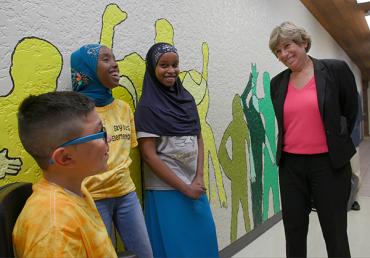The high cost of defunding public education
Time magazine’s back-to-school cover story is far from a feel-good puff piece. Alongside the image of a woman seated in a classroom is the headline: “I have a master’s degree, 16 years of experience, work two extra jobs and donate blood plasma to pay the bills. I’m a teacher in America.” It’s infuriating. The question now is whether lawmakers’ priorities will change.
For all the talk about the importance of education and declarations that teaching is one of the most valued professions, the recent school walkouts across the country not just exposed how widespread disinvestment is, how low teachers’ pay and how high their healthcare costs are—it exposed the worsening conditions in public schools, such as crumbling buildings and the diversion of resources to private alternatives, particularly for children of color and children from low-income families.
Teachers dig into their own pockets—and deep into their souls—to ensure their students get the public education they deserve, while lawmakers persistently underfund public schools. Today, 25 states spend $19 billion less on public K-12 education than before the Great Recession, according to a recent AFT report. States that have made policy choices to slash taxes for the wealthy are the worst offenders. This chronic underfunding explains why, in 38 states, the average teacher salary is lower in 2018 than it was in 2009, and why the pupil-teacher ratio was worse in 35 states in 2016 than in 2008.
Education Secretary Betsy DeVos sought to cut public education funding by $9 billion and to eliminate all summer school programs, after-school programs and initiatives to reduce class size. She proposed spending more than $1 billion on private school vouchers and other “school choice” plans, a down payment on what a former Trump administration official described as DeVos’ plan to “replace public education with for-profit schools.” Her big back-to-school idea this year was to divert funding for guidance counselors, mental health services and enrichment programs for poor kids in order to arm educators with guns.
DeVos is but the latest public official to shortchange children’s educational opportunities. A report released last week by the Alliance to Reclaim Our Schools found that, between 2005 and 2017 (the length of time between a student entering kindergarten and graduating from high school), public schools in the United States were underfunded by $580 billion in federal Title I and Individuals with Disabilities Education Act dollars alone—money that is targeted specifically to support 30 million of our most vulnerable students.
DeVos rarely sets foot in public schools. If she did, she’d see educators striving to give their students the opportunity to learn. Last week, teachers in a high-poverty elementary school in Burnsville, Minn., proudly showed me classrooms with reading nooks, educational games and extra supplies—all purchased with teachers’ own money—so no child would have to go without. Educators in rural Massena, N.Y., organized a “Ready-4-School” event so students could get free school supplies, clothing, books and even haircuts. And in Baltimore, where many schools were too cold last winter and too hot in recent weeks to conduct classes, school staff recently helped distribute more than $30,000 worth of books and school supplies to students in need.
I hear the same things over and over from teachers: Disinvestment in public education is hurting kids and hurting educators. They’re struggling to get by on salaries that don’t reflect the importance of their work. They’re frustrated by their lack of latitude to meet children’s needs, because decisions about instruction and classroom assessment are driven more by standardized testing than by teaching and learning. And yet, they persist.
And they have the public’s support. The 2018 PDK poll of Americans’ attitudes about public schools found that most Americans have trust and confidence in public school teachers. They agree that teachers are underpaid and say they would support them if they went on strike for better wages. And, as they have for nearly two decades, Americans cite lack of funding as the biggest problem facing their local schools.
Another concern is ensuring that our schools are safe and welcoming. Since the beginning of the 2016 presidential campaign, teachers have reported dramatic increases in incidents of harassment and bullying in schools—a troubling trend confirmed by law enforcement and civil rights groups. And, of course, there are worries about gun violence again occurring in schools.
Next month in Washington, D.C., we’ll convene the student-led Student Gun Violence Summit. Working with teachers and students from all over the country, student representatives will review existing plans to reduce gun violence, develop a “Students’ Bill of Rights” on gun safety and craft a corresponding action plan.
Yet in these troubling and tumultuous times, there is hope. We have become a rallying nation, and increasingly, those rallying cries are being led by the nation’s educators and young people. That is the promise of America and the promise of public education.

